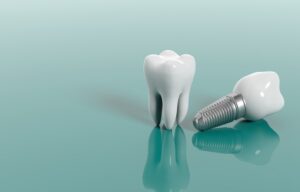Dental implant surgery
This process can take several months for the jawbone to heal and prepare to receive the final implant. If the jawbone is not strong, the implant will not take, so it is important to be patient during the healing process.
Dental implant surgery and bone grafting
The part of the jawbone that is to receive the implant may not be thick enough or may be too soft. Since the jaw generates a lot of pressure when chewing, the bone must be extremely strong to chew and to protect the dental implant once it is surgically added to the gum line.
Depending on the structure of the jawbone, it may be necessary to add a small piece of extra bone so that the implant site has a stronger base. This is done through bone grafting, a procedure in which a small piece of bone is grafted to solidify the implant base in the jawbone. The bone graft is usually taken from another area of the upper or lower jawbone away from the dental implant area, but it can also be taken from another part of the body.
The condition of the jawbone determines whether the bone needs to heal first or whether the additional bone structure can be added at the same time as the implant (which is the ideal situation in terms of time). While the implant is healing, you wear a temporary denture to maintain the appearance of a tooth. The denture is removable and must be kept clean.
During this time, osseointegration takes place. During osseointegration, the bone begins to grow and bond with the implant surface to become part of the natural gum line. The process can take up to three to nine months and will proceed much like the roots of a natural tooth.
Laying the pillar
Once the healing and osseointegration processes are complete, the abutment is placed. The abutment is the part that screws into the dental implant and on which the artificial tooth will be attached later. The abutment is placed in a minor outpatient procedure, normally performed with local anesthesia. The abutment can be attached to the implant during the initial implantation phase, but many people are not concerned about the visibility of the abutment and choose to have a second procedure to place it later.
To place the abutment, the oral surgeon reopens the gum to expose the dental implant, then the abutment is attached to it. The gum tissue is then closed around the abutment and is allowed to heal for one to two weeks.
Choosing artificial teeth
Once the gums have healed, additional impressions of the mouth and remaining teeth are made so that the artificial tooth, or crown, for the dental implant can be made. There are two main types of artificial teeth to choose from: a removable implant prosthesis or a fixed implant prosthesis.
The removable option is similar to a removable denture that is attached to a metal frame that fits securely over the implant abutment. This option is a great choice because it can be easily removed for cleaning and replacement, especially when multiple teeth have been removed and dental implants need to be replaced. It is also a stronger and more affordable option.
If you choose a fixed implant, you should know that the tooth cannot be removed for cleaning and that replacing it is more complicated. It is permanently screwed to the abutment or it is glued. If several teeth need to be replaced with implants and the financial aspect is not an issue, you can have them all replaced this way, with each crown attached to its own separate dental implant.












Post Comment
You must be logged in to post a comment.